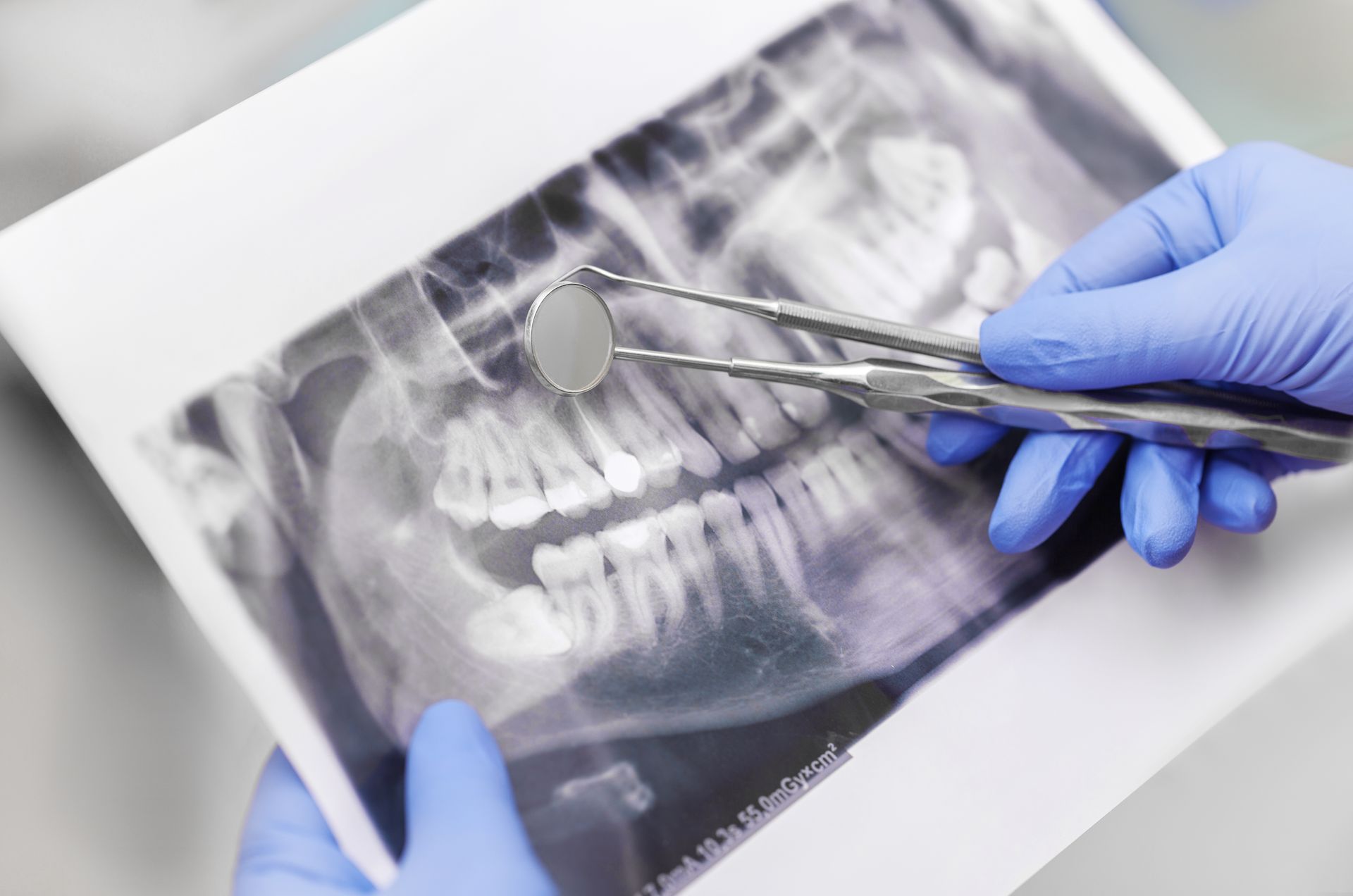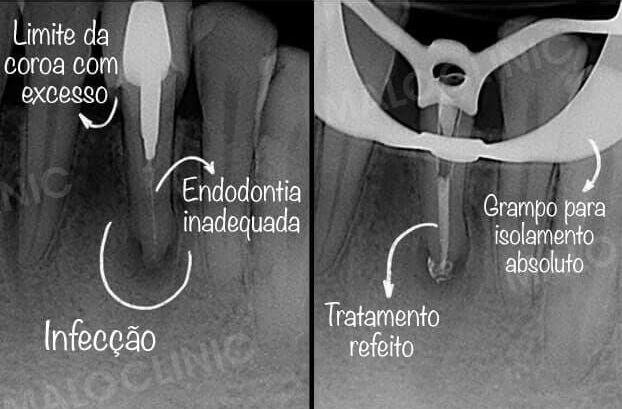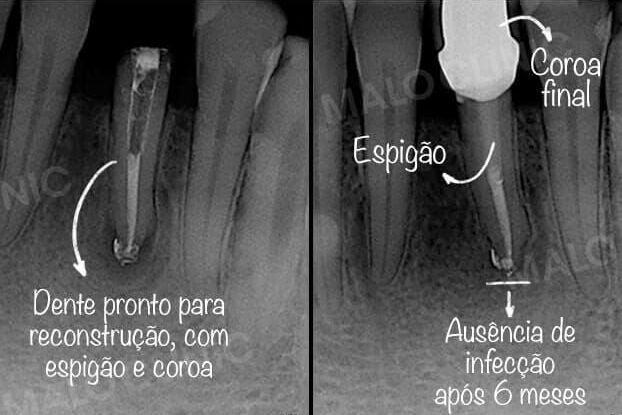Endodontics
About the speciality of Endodontics
Endodontics: treatment of dental pain and sensitivity
Endodontics is the specialty of dental medicine that treats pathologies of the dental pulp (commonly known as the nerve).
The dental pulp is located inside the tooth and is surrounded by hard tissue -dentin - and is responsible for the nutrition and sensitivity of the teeth, through the blood vessels and nerves that make it up.
Injuries to the dental pulp can be caused by deep tooth decay, trauma, fractures and infections. Symptoms indicative of a dental infection include spontaneous pain, sensitivity in teeth exposed to cold and/or heat and discomfort to the touch and during chewing, while the presence of an abscess or fistula (small bubble of pus in the gum) is also common.

In cases of necrosis or irreversible inflammation of the dental pulp, endodontics (root canal) is the only solution to save the tooth and avoid other complications, such as dental infection and gum abscesses.
As well as eliminating the pathology of the pulp, root canal removal, together with subsequent reconstruction, restores the tooth's chewing function. There is also the possibility of performing a re-endodontic procedure, which consists of re-treating the root canals. This should always be the first option for teeth that have failed previous root canal treatment.
In a root canal retreatment, all the contents inside the root canal system are removed, disinfected again and prepared and filled three-dimensionally. Once the retreatment is complete, the tooth is also restored.
Benefits of Endodontics for Oral Health
Pain Relief
Endodontic treatment is often carried out to relieve the intense pain associated with inflammation or infection of the dental pulp. By removing the damaged pulp, pain and discomfort are relieved. Recovery from treatment is usually rapid, allowing patients to resume their normal activities soon after the procedure.
Preservation of Dental Structure
Endodontics preserves the tooth's natural structure, saving teeth that would otherwise end up being extracted. In addition to the tooth retaining its original function, this maintains the integrity of the dental arch and avoids occlusion and movement problems in adjacent teeth associated with tooth loss. Technological advances and innovation in the materials used for root canalization, while maintaining the necessary maintenance, ensure the longevity of this type of treatment.
Infection Prevention
By removing the infected dental pulp and disinfecting the tooth's root canals, the treatment helps to prevent the infection from spreading to the surrounding tissues, such as the bone and gums.
Endodontics treatments available

Endodontic Treatment
Non-Surgical
(devitalization)
Using local anesthesia, an opening is made in the tooth to remove the infected dental pulp, fill and seal the tooth's root canals. Depending on the complexity of the case, it is not always possible to carry out the full treatment in just one appointment. In these cases, a temporary restoration is placed in the access opening, with the aim of protecting the tooth between appointments until its definitive reconstruction. The use of the latest technologies allows treatments to be carried out with greater comfort, predictability and efficiency. By magnifying the complex system of root canals that make up the tooth, the electronic microscope allows the dentist to disinfect and fill in areas that would be difficult to see without magnification.

Non-Surgical Endodontic Retreatment
(re-devitalization)
In cases of unsuccessful root canal treatment or reinfection, retreatment may be necessary to save the tooth. Once again, microscopic endodontics plays a decisive role in the success of root canal retreatment, as it is essential to identify and treat canals that were not properly cleaned during the initial treatment. The microscope facilitates not only the identification of these canals, but also the precise removal of previous filling materials.

Endodontic Microsurgery (apicectomy)
In cases where Non-Surgical Endodontic Retreatment fails to resolve the associated infection or there are previous procedural errors that prevent good retreatment, Endodontic Microsurgery is an alternative for combating the infection and keeping the tooth in place. Microscopy is once again indispensable for the success of this procedure.
Clinical Cases
Endodontics Retreatment


Our Clinical Team is here to help you!
Clinical Team
FAQ's
1. What symptoms may indicate the need for endodontic treatment?
There are several signs and symptoms that may indicate the need for endodontic treatment (root canal treatment):
- Intense or continuous pain in the tooth, especially when chewing or applying pressure, which may indicate an infection in the dental pulp;
- Extreme sensitivity to heat and/or cold, lasting more than a few seconds after the stimulus has been removed;
- Swelling in the gums or areas around the tooth can indicate infections affecting the dental pulp;
- Physical trauma or injury that results in fractures or significant damage to the tooth and can expose and compromise the health of the dental pulp;
- A change in the color of the tooth, to gray or even black can be indicators of pulp death.
If you are experiencing one or more of these symptoms, it is important to consult a dentist as soon as possible for a proper assessment of the need for endodontic treatment. Early treatment can help preserve the tooth and prevent more serious complications in the future.
2. Is endodontic treatment painful?
Treatment is carried out using local anesthesia, ensuring that you feel no pain throughout the procedure. The precision and efficiency provided by Microscopic Endodontics also result in less invasive and smoother procedures for patients, which help to reduce post-treatment discomfort and speed up the recovery process. Even so, after the procedure you may experience slight discomfort, which is easily controlled with painkillers recommended by your dentist.
3. What care should be taken to prolong the longevity of endodontic treatment?
After endodontic treatment, it is important to take certain precautions that will certainly contribute to the longevity of the treatment. For example, in the first few days after treatment you should avoid hard, sticky or very hot foods, as they can cause discomfort or damage the treated tooth. You should also avoid activities that could cause trauma to the treated area, such as grinding your teeth, biting hard objects or playing impact sports without adequate protection. If the dentist prescribes medication, such as painkillers or antibiotics, it is essential to take them responsibly, following the instructions, to help control pain and prevent infections. To ensure the longevity of the treatment, it is also important to maintain good oral hygiene, brushing your teeth at least twice a day, without applying too much pressure to the treated area. In addition, it is essential to use dental floss to remove any residue that may have been left between the teeth. Don't forget to follow the dentist's recommendations regarding follow-up appointments for the treated tooth and make any adjustments that may be necessary.










